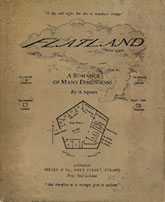Flatland
Critique • Quotes
 First edition
First editionOriginal title
Flatland: A Romance of Many Dimensions
First publication
1884
Literature form
Novella
Genres
Satire, science fiction
Writing language
English
Author's country
England
Length
Approx. 33,000 words
Curious and less curiouser
Flatland is a curiosity. This novella, fable, allegory, satire or math lesson—whatever it's supposed to be—is often counted as a classic science fiction work.
From a bare description of Flatland, I could see why. A hypothetical world of only two dimensions is described within which all things, including the inhabitants, are composed of flat geometric figures. In the course of the story, one of these the two-dimensional creatures, the narrator who is a Square, visits alternate worlds of zero, one and three dimensions. He also ponders the existence of higher order realms. Speculative all right. One of the qualities that makes it SF.
But not very good SF.
Let's take the hard science part first. A lot of fans say Flatland appeals to them because they're math nerds. However, the geometry of this story is rather primitive. And it cheats. If you get off on imagining how the world would appear if it—and we—had only two dimensions, I'm not sure this story would help.
Just one example: If you saw only two dimensions—say, width and depth—you'd be viewing everything edge-on. And because there's no height, you wouldn't even see these things as lines, since even the thinnest lines have thickness. Abbott gets around this by saying his creatures see leading edges as brightly shining. But, when you think about it, you must realize that a glowing edge also has height. Without having senses for the third dimension, Flatlanders should not be able to see even those edges.
The view from above
To tell the truth, I'm not even sure whether Flatland is experienced as flat because (a) the world of Flatland has only two dimensions or (b) because the dwellers in the world can perceive only two dimensions. Through most of the description of the world, it seems (a) is the case.
Then a visiting Sphere arrives to introduce the Square to the idea of three dimensions. It's explained how the Sphere sinks into the plane of Flatland, appearing as a circle there. But it must appear from somewhere outside of Flatland, so it seems the world is indeed three-dimensional and (b) is the explanation. Moreover, somehow the Sphere manages to bump Square up off the surface of Flatland into the space above it.
Okay, I could nitpick this thing to death. I won't even get into the problems with Flatland that arise from our more sophisticated understandings of spatial and temporal dimensions today. After all, we can still read and enjoy classic science fiction works that involve canals on Mars, shooting cannons at the Moon, and space ships travelling faster than light.
Besides, aren't I missing the point with these technical details? Most appreciations of Flatland go on about its social satire. Britain's rigid class society of Abbott's time, the subservient role of Victorian women, the suppression of new ways of thinking—all are supposedly among the satirical targets.
I admit there is a bit of Jonathan Swift in Abbott and a bit of Gulliver's Travels in Flatland.
But only a bit. The stagnant, flat world is outlined quickly in a fanciful fashion without any notion of real suffering. Your rank in the social order is determined by the number of sides your shape has, which is based on a kind of progressive heredity. The intelligence of triangles is set by how deep they are. Women are shallow triangles, but they have sharp angles that can pierce others. And so on. There are revolts against the established order but they are put down rather bloodlessly.
Not the usual SF
It's really all just setup in the first half of Flatland for Abbott's point stressed in the second half that we are oppressed by our failure to imagine other worlds. And that there's nothing we can do to change ourselves.
For some reason, though, lots of people find this an intriguing read. It certainly is different from the usual run of literature, even science fiction literature.
It's worth reading once to see if it sparks any interesting thoughts in your mind. We should all try completely different kinds of books every now and then, just to shake up the little grey cells.
Flatland is a curiosity. But not a place I need ever visit again.
— Eric
Critique • Quotes


